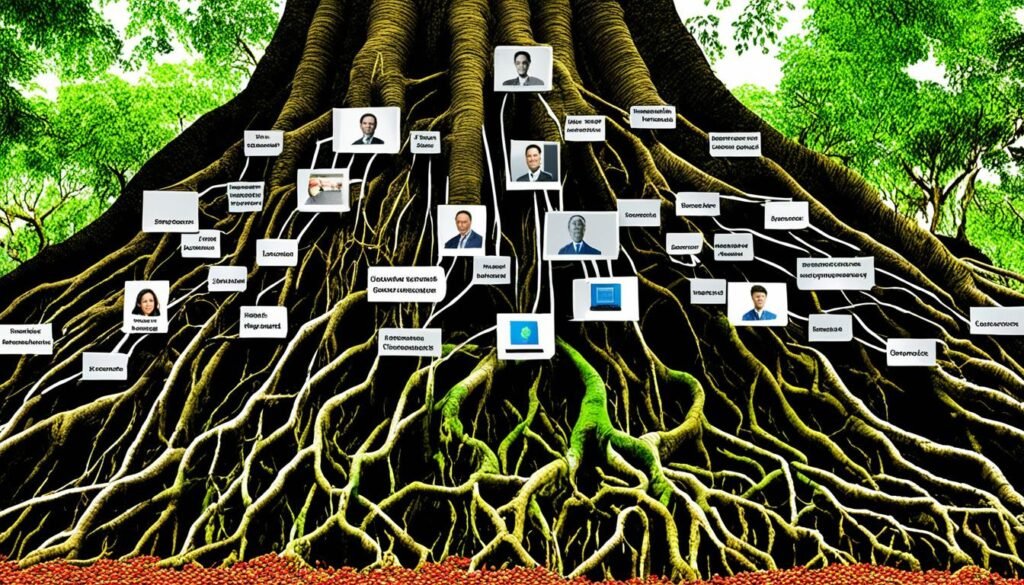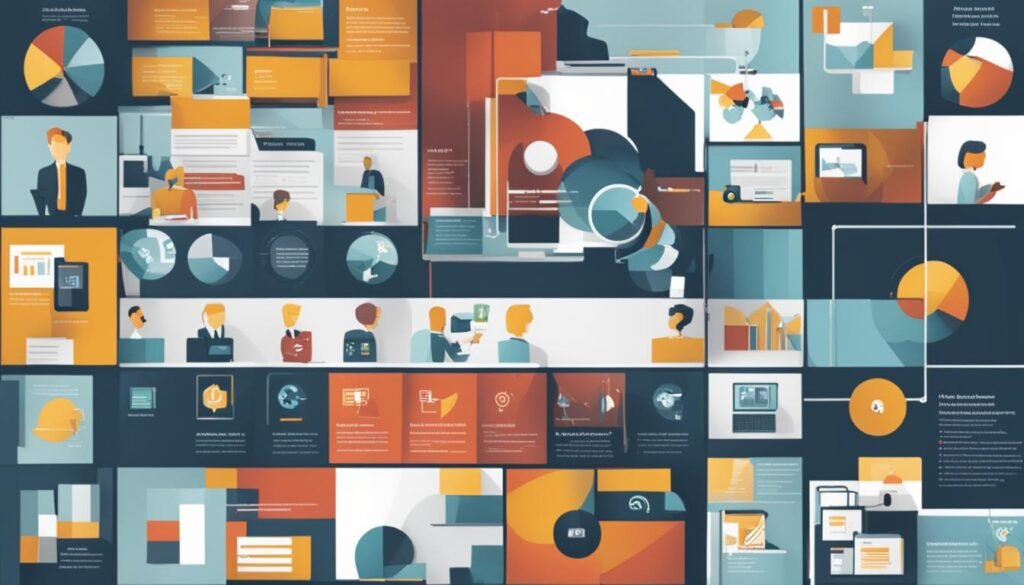The concept of optimizing costs involves understanding the strategic integration of people, process, and technology. Technology plays a significant role in improving productivity and effectiveness, but it is equally essential for the other two elements, people and processes, to properly support it. Optimizing costs is not just about cost-cutting but also ensuring that resources are dedicated to the organization’s strategic direction. It requires a comprehensive framework that considers how technology, people, and processes work together to achieve organizational efficiency.
Key Takeaways:
- Strategic integration of people, process, and technology is crucial for optimizing costs.
- Technology improves productivity, but it relies on the support of people and processes.
- Optimizing costs involves resource allocation aligned with strategic direction.
- A comprehensive framework considers the interplay of technology, people, and processes.
- Organizational efficiency is the ultimate goal of optimizing with people process technology.
The Three Elements of the PPT Framework
The PPT framework, which stands for people, process, and technology, is a strategic approach to optimizing organizational efficiency. This framework recognizes the interplay between these three essential elements and emphasizes the need for a balanced integration to achieve optimal performance. Let’s dive deeper into each element of the PPT framework:
1. People
The first element of the PPT framework is people. This refers to the workforce within an organization who are responsible for executing tasks and implementing change. Having the right people in place is crucial for the successful implementation of any technology or process. A well-equipped and capable workforce ensures that the organization can leverage technology and optimize processes to drive efficiency.
2. Process
The second element of the PPT framework is process. This encompasses the steps, procedures, and actions that lead to a specific goal. Efficient processes are key to streamlining operations, ensuring consistency, and maximizing productivity. By adopting best practices and continuously improving processes, organizations can achieve better outcomes and enhance overall efficiency.
3. Technology
The third element of the PPT framework is technology. This refers to the tools, systems, and automation solutions used to support and enhance processes. Technology plays a critical role in enabling automation, improving efficiency, and providing organizations with a competitive edge. However, it is important to note that technology alone is not sufficient. It must be implemented and utilized effectively in conjunction with the other two elements, people and process, to drive optimal results.
The PPT framework highlights the need for a holistic approach that considers the relationship between people, process, and technology. By strategically integrating these three elements, organizations can achieve organizational efficiency and unlock their full potential.
The Role of Technology in the PPT Framework
Technology plays a vital role in the PPT framework, as it enables automation, streamlines processes, and enhances overall efficiency. However, technology alone is not sufficient for achieving optimal results. It must be implemented in conjunction with the other two elements of the framework, namely people and processes.
The effective use of technology relies on individuals who possess a deep understanding of both the technology itself and the specific processes it supports. People are the ones who leverage technology to enhance productivity and streamline operations.
Implementing new technology can also facilitate organizational change by providing new capabilities and integrating seamlessly with existing processes. It has the potential to revolutionize the way individuals and teams work, leading to increased efficiency and improved outcomes.
The interplay between technology and processes is a crucial aspect of the PPT framework. When technology is implemented in a way that aligns with organizational goals and integrates seamlessly with existing processes, it can lead to significant improvements in efficiency and effectiveness.
However, it is important to note that technology should not be seen as a standalone solution. It is the people and the processes that drive the successful implementation and utilization of technology in achieving organizational goals.

The Importance of Processes in the PPT Framework
In the PPT framework, processes play a crucial role in optimizing organizational efficiency. They determine how tasks are carried out and how resources are allocated, making them essential for productivity and achieving goals. By optimizing processes, organizations can ensure the effective use of resources and adherence to best practices, resulting in improved performance.
One model that can guide process improvement efforts is the diamond model, which considers the interplay between tasks, people, structure, and technology. This model helps identify areas for improvement and highlights the need for a balanced approach to process optimization.
“The diamond model provides a holistic view of processes, emphasizing the importance of considering the interrelationships between tasks, people, structure, and technology. By understanding these interdependencies, organizations can identify bottlenecks, streamline workflows, and enhance efficiency.” – Harold Leavitt
It is crucial to obtain buy-in from stakeholders when implementing process changes. Getting the support and commitment from key individuals and teams within the organization ensures smoother implementation and better adoption of new processes.
Furthermore, employing project management techniques is essential to ensure successful process implementation. Project management provides a structured approach to identify project objectives, define tasks, allocate resources, and monitor progress, enabling organizations to effectively manage process improvements.
Processes should also be aligned with digital transformation initiatives. As organizations undergo digital transformation, it is essential to integrate technology into business processes effectively. By aligning processes with digital transformation, organizations can leverage technological advancements to drive innovation, increase efficiency, and enhance customer experiences.
To measure the effectiveness of processes, organizations need to establish appropriate metrics. These metrics should align with organizational goals and provide insights into process performance. By tracking and analyzing relevant metrics, organizations can identify areas for improvement, make informed decisions, and drive continuous process optimization.
In conclusion, processes play a vital role in the PPT framework by optimizing productivity, ensuring best practices, and supporting organizational goals. By considering the interplay between tasks, people, structure, and technology and utilizing project management techniques, organizations can streamline processes and drive successful implementation. Aligning processes with digital transformation and measuring their performance using appropriate metrics further enhances organizational efficiency.
The Significance of People in the PPT Framework
Within the PPT framework, people play a crucial role in driving organizational efficiency and success. They are responsible for executing tasks, making critical decisions, and interacting with both technology and processes. The framework recognizes that technology and processes can only be effective when the right people are involved, bringing their expertise and decision-making capabilities to the table.
By having the right people involved, organizations gain valuable visibility into their operations. This visibility allows for a deeper understanding of how people interact with technology and processes, leading to more informed decision-making and streamlined workflows. The interplay between people, technology, and processes becomes apparent, highlighting the need for proper training and understanding of this dynamic relationship.
Implementing new processes or technologies within an organization requires careful consideration of the people involved. Having the right individuals with the necessary knowledge and skillset is essential for successful implementation. Investing in training programs and ensuring that employees are equipped to adapt to new technologies and processes is crucial.
Additionally, selecting the right technology is paramount to support the needs of the organization and its workforce. The right technology can save time, enhance productivity, and optimize decision-making. Investing in information technology and aligning it with business process management can yield significant returns on investment and enable organizations to remain competitive in today’s rapidly evolving landscape.
Harold Leavitt: Shaping Decision-Making and Visibility
“The implementation of the PPT framework must focus on the dynamic interplay between people, technology, and processes. Organizations must understand the importance of investing in the right technology and ensuring that people are involved in decision-making processes to drive visibility into operations.” – Harold Leavitt
| Benefits of People in the PPT Framework | Examples |
|---|---|
| Expertise | Employees with specialized knowledge can contribute valuable insights and expertise to improve processes and decision-making. |
| Decision-Making | Engaging the right people in decision-making processes ensures a diverse range of perspectives and enhances the quality of decisions made. |
| Visibility Into Operations | People provide a firsthand understanding of how technology and processes interact, enabling organizations to identify inefficiencies and areas for improvement. |

Overall, the significance of people in the PPT framework cannot be overstated. Their involvement and expertise contribute to the effective implementation of new processes and technologies. When organizations prioritize the right technology alongside the right people, they gain a competitive advantage, save time, and drive better decision-making. The PPT framework recognizes that organizational success relies on the harmonious interplay between people, processes, and technology.
Implementing the PPT Framework
Implementing the PPT framework is a crucial step in optimizing organizational efficiency and achieving optimal results. This involves effectively aligning the three key elements of the framework: people, process, and technology. By understanding how these elements interact and training people to use technology effectively, organizations can streamline their overall processes and drive continuous improvement.
The PPT framework recognizes that technology alone is not enough to achieve desired outcomes. It requires the active involvement of people who understand both the technology and the overall process. By providing the necessary training and support, organizations can ensure that the right people are equipped with the skills and knowledge needed to succeed.
The overall process is an essential component of the PPT framework. It is necessary to evaluate existing processes and identify areas for improvement. By implementing the framework successfully, organizations can enhance process efficiency and drive overall organizational performance.
Continuous improvement is a fundamental aspect of the PPT framework. Organizations must continuously evaluate how well the framework is working and make adjustments as necessary. This focus on continuous improvement ensures that organizations can adapt to changing circumstances and continue to optimize their processes.
In summary, implementing the PPT framework is key to achieving organizational efficiency and driving continuous improvement. By effectively aligning the elements of people, process, and technology, organizations can streamline their processes, improve performance, and stay ahead in today’s competitive business landscape.

| Benefits of Implementing the PPT Framework | Key Components | Implementation Process |
|---|---|---|
|
|
|
Achieving Organizational Efficiency with the PPT Framework
The PPT framework, which strategically integrates people, process, and technology, is instrumental in helping organizations achieve organizational efficiency. By leveraging this framework, businesses can optimize their operations and drive overall performance.
Implementing change within an organization is a complex task. The PPT framework facilitates effective change management, enabling businesses to navigate through transitions smoothly. It provides a structured approach to understanding the interplay between people, process, and technology, ensuring that the right decisions are made throughout the change process.
Strong processes are paramount to achieving organizational efficiency. The PPT framework emphasizes the importance of developing and maintaining robust processes. These processes act as the backbone of operations, enabling streamlined workflows and effective utilization of resources. When combined with investments in technology, organizations can experience a positive return on investment.
Effective business management is a key factor in driving organizational efficiency. The integration of people, process, and technology within the PPT framework creates a cohesive environment that supports business goals. This framework also enables organizations to adapt to changes in the industry, ensuring they stay competitive and relevant.
The role of each element within the organization is critical to the success of the PPT framework. People bring expertise, decision-making capabilities, and an understanding of the organization’s specific needs. Process defines how tasks are carried out and how resources are allocated. Technology provides the necessary tools and systems to support and automate processes. Together, these elements make it possible to achieve organizational efficiency.

Implementing the PPT framework is an essential step in driving organizational efficiency. It allows businesses to optimize their processes, make informed decisions, and enhance overall performance. By recognizing the importance of each element and understanding their role within the organization, companies can position themselves for success in an ever-evolving business landscape.
Overcoming Challenges and Realizing the Benefits
Implementing the PPT framework can present various challenges for organizations. To achieve organizational efficiency, it is crucial for businesses to have the right processes in place and to be able to implement new processes effectively. This requires assessing the current work that needs to be done, streamlining service management, and ensuring easy access to relevant information.
In order to create the right processes, organizations must consider management practices that make things easier and allocate sufficient time and resources for implementation. Additionally, employees’ skills and knowledge must align with the requirements of the framework, so adequate training and development initiatives must be made.
While implementing change can be complex, it is essential for organizations to create the necessary harmony within by getting buy-in from stakeholders and ensuring that the framework is efficient enough to enable change more effectively. Despite the challenges, the benefits of successful implementation are numerous.
Successfully implementing the PPT framework brings the elements of people, process, and technology together, resulting in better outcomes and enhanced organizational development. It allows for improvements in customer experience and overall efficiency, achieving organizational efficiency as Harold Leavitt’s diamond model is applied to create change within the company’s culture.
The right processes in place, supported by effective technology and skilled individuals, enable organizations to achieve optimal performance. This aligns with Leavitt’s diamond model, which emphasizes the interplay between tasks, technology, people, and structure to achieve organizational efficiency. A successful implementation of the PPT framework helps every company to create a harmonious environment where all these elements work together seamlessly.

By implementing the PPT framework, organizations can optimize their service management, store and access information effectively, and create the right processes to drive change and improve customer experience. With the added benefits of better outcomes and efficient organizational development, the PPT framework is an essential tool for organizations seeking to enhance their performance and achieve long-term success.
Also Read : How Blockchain Technology Is Changing The Game
Conclusion
The PPT framework offers a strategic integration of people, process, and technology to optimize organizational efficiency and achieve optimal performance. By considering the interplay between these three elements, organizations can drive change management and digital transformation initiatives that lead to continuous improvement.
Implementing the PPT framework requires a balanced approach that acknowledges the importance of people, process, and technology. It is not simply about cost-cutting, but about strategically allocating resources and aligning them with the organization’s goals.
Continuous improvement is vital for ongoing success within the PPT framework. By leveraging the framework, organizations can enhance their performance, streamline their processes, and drive innovation. This enables them to adapt to changing environments and maintain their competitive edge in the digital era.
Embracing the principles of the PPT framework empowers organizations to optimize their operations, achieve organizational efficiency, and drive optimal performance. It provides a comprehensive framework that guides their efforts in change management, digital transformation, and continuous improvement, ensuring they stay ahead in an ever-evolving business landscape.
FAQ
Q: What does optimizing with People Process Technology mean?
A: Optimizing with People Process Technology refers to the approach of using the combined factors of people, process, and technology to improve organizational efficiency and effectiveness.
Q: How does the technology framework factor into optimizing with People Process Technology?
A: The technology framework plays a crucial role in providing the necessary tools and systems to support and streamline organizational processes and interactions.
Q: What is the significance of organizational change in the context of optimizing with People Process Technology?
A: Organizational change is essential as it involves adapting to new processes, technologies, and practices to achieve greater efficiency and effectiveness.
Q: What are some best practices for optimizing with People Process Technology?
A: Best practices may include effective project management, understanding and addressing the needs of people using the technology, and implementing change more effectively within the organization.
Q: How does project management contribute to optimizing with People Process Technology?
A: Project management ensures that the implementation process is well-coordinated, on track, and considers the needs of people and the overall process.
Q: Why is it important to understand the metric of people using the technology within People Process Technology framework?
A: Understanding the metric of people using the technology is crucial for evaluating the impact and effectiveness of the technology on organizational efficiency and performance.
Q: Who is Harold Leavitt and what is his relevance to optimizing with People Process Technology?
A: Harold Leavitt is known for his work on organizational and management theory, particularly emphasizing the way people interact with information technology and the overall process within organizations.
Q: What is the role of change more effectively within the context of optimizing with People Process Technology?
A: Change more effectively involves implementing changes, such as new technologies and processes in place, to achieve organizational efficiency and effectiveness.
Q: What are the key elements within the People Process Technology framework that require attention?
A: The key elements include the need to understand the role of people, process, and technology, as well as the interactions and interdependencies among these elements within the framework.
Q: How can an organization ensure that people are trained effectively within the People Process Technology framework?
A: Organizations can ensure effective training for their personnel by implementing a new service management system to store and access training materials and resources.
Source Links
- https://www.plutora.com/blog/people-process-technology-ppt-framework-explained
- https://whatfix.com/blog/people-process-technology-framework/
- https://mpowr.com/blog/optimize-your-costs-now-for-the-future-using-people-processes-and-technology/




